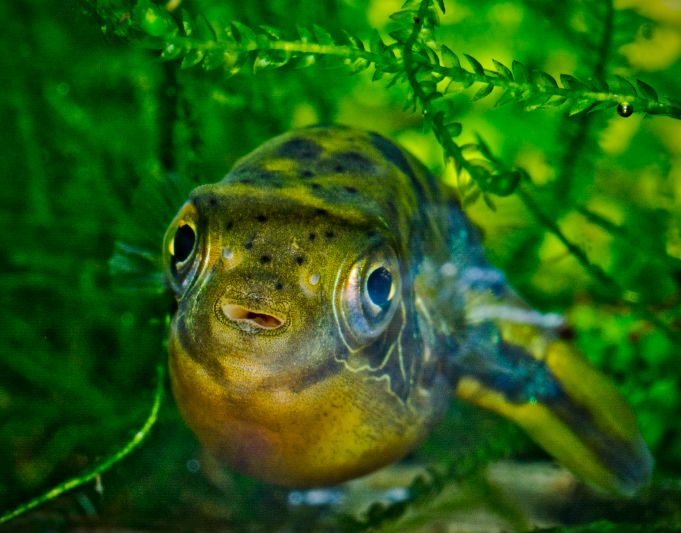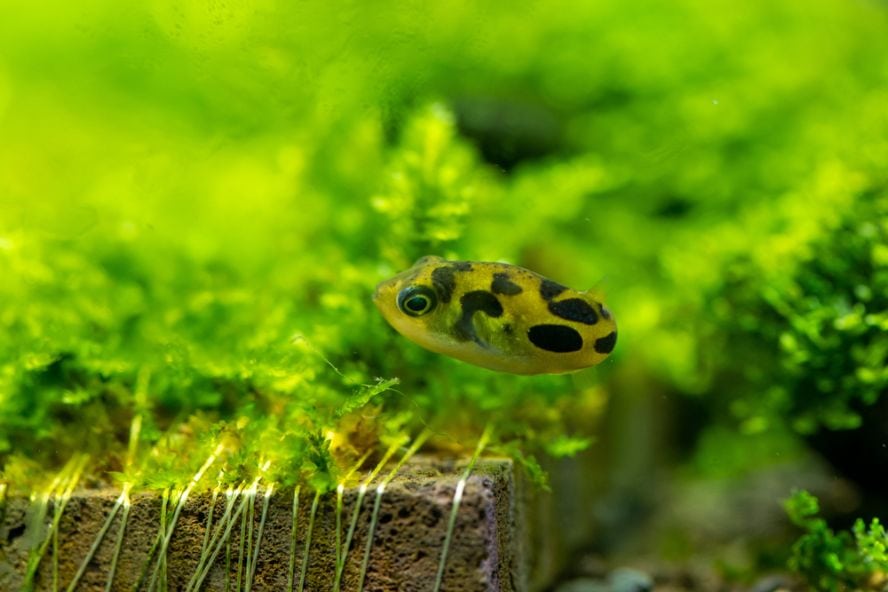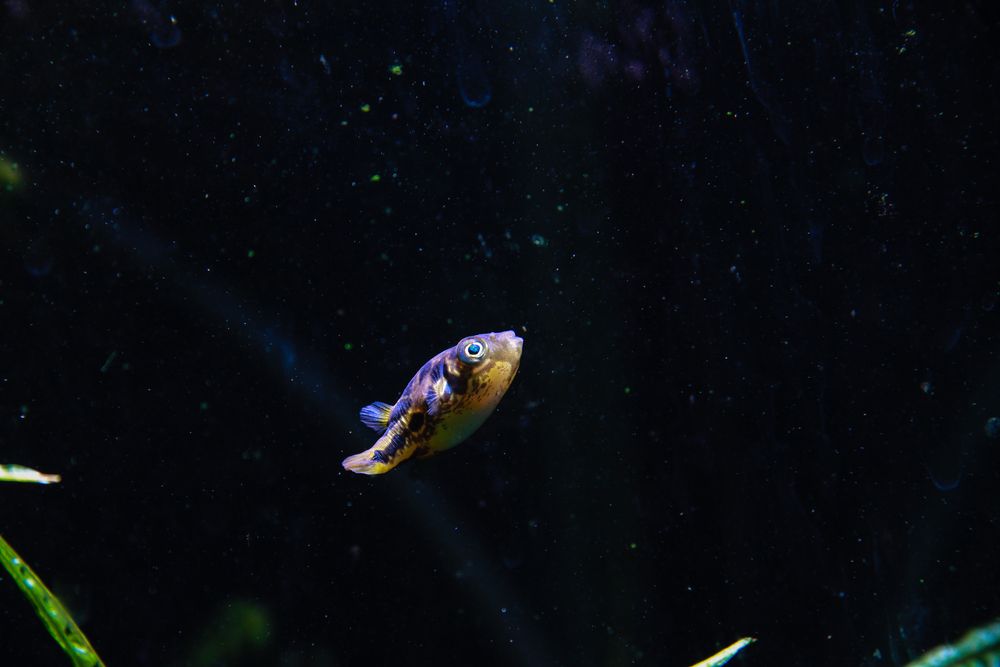The dwarf pufferfish has a great many names including its scientific name, the carinotetraodon travancoricus. Other names include the pea puffer, the pygmy puffer, and the Malabar pufferfish. They are freshwater fish that are native to Southwest India. Unfortunately, these cute creatures are in jeopardy due to being sought after in the aquarium trade and of course, loss of their habitat.
They can still be seen in some rivers around India but are rare in others. They come in cute patterns and as their name suggests, they are also on the smaller side. These traits are what make them very popular with aquarists who want to boast about this unique addition to their tank.
These unassuming little creatures of the water have the ability to expand just like their larger puffer fish counterparts do, but the dwarf puffer fish isn’t quite as intimidating in their puffed-up state. Let’s get to know more about dwarf puffers.
Table of Contents
Dwarf Pufferfish Care Level
Depending on varying opinions, the dwarf puffer fish is elementary to intermediate in terms of care. For aquarists, however, they are the best puffer of choice. Due to their stature, they don’t need a lot of space while larger puffer fish would. They are relatively easy to keep except for their sensitivity to water changes.
If you are a beginner, we would advise trying your hand at more robust and hardy fish that won’t detect changes to the water as easily. Once you have had enough practice, then try to graduate to these little water balloons. Even though they are not as abundant in numbers as before, they fetch a very affordable price on the market – at about $4 for each.
Dwarf Pufferfish Temperament and Behavior
Most pufferfish species are territorial and like the solo life, but the pea puffer actually likes to group together in shoals. However, puffer fish are known to be bullies, and that is no exception even with the dwarf puffer’s small size. They tend to be aggressive, especially if the victim is a smaller size than the pufferfish. You may be in luck here because there aren’t many tank creatures smaller than the dwarf puffer!
Not only are they aggressive to other species, but there is also a large possibility that your dwarf pufferfish will fight among themselves as well. There is a way to combat this aggression, and that is to deliberately keep more females than males in the tank. The golden ratio you’re looking at is one male with around 3 females in a tank. Not only will that lessen the attacks and bullying, but it will also encourage breeding – but more on that later.
Since they are so small, we can assume that they are often preyed upon in the wild. Smaller creatures like this often like to hide among aquatic plants for safety. What these carinotetraodon travancoricus like to do is to feed in open water but they can be found occupying all areas of your tank.
They are also a smart and alert species that are often aware of their surroundings. Don’t be surprised if you find your little pea puffer watching your every move through the glass. They like to keep an eye on their tankmates as well as their human!

Dwarf Pufferfish Appearance
Talking about the appearance of these different species is what interests a lot of people.
A lot of folks wonder just how big does a dwarf puffer fish get?
We already know that they are small, very small in fact measuring at just around 1 inch. Studies have been done and the maximum size for these little creatures is only about 0.4 inches more than that, which gives them the crown for being one of the smallest puffers on the planet!
They are shaped like most other pufferfish with rounder abdomens and they thin out and lengthen towards their anal fins. Their eyes are also exceptionally large compared to the rest of their body. Snapchat had a filter that resembles the dwarf pufferfish. Those of you who know what we are talking about can get a sense of how big the eyes are.
Unlike some tank species, the male dwarf pufferfish, which are brighter than females in general, are easily distinguishable from the female. Males are brighter in color around the abdomen, while the females are of a paler yellow. One other very obvious distinguishing feature is the dark stripe males have across their belly that females lack. Typically, males have a golden tint to their greenish coloration while females are more of a yellowish-green hue.
Both sexes are seemingly polka-dotted or patched on the top side of their body, but the difference is the dark stripe that males exhibit and the females only have small black spots. If you look closely enough, you will also see that the males have wrinkles around the bulbous eyes while females do not.
What’s really cool about the dwarf pufferfish is that before they mature they are considered asexual. The first pea puffer that becomes male will excrete a hormone to prevent all others around him from becoming male (talk about oppression to the next level).
There are cases where two pufferfish become male at the same time. In these cases, there will always be a more dominant male in the tank. However, it’s also worth it to note that although females are more lacking in vivid hues, they are larger than their male counterparts.
Dwarf Pufferfish Lifespan
How long can these creatures live?
They are quite popular due to the fact that they can keep you company for quite a while. With proper maintenance and care, the dwarf pufferfish can live around 4 – 5 years. So if you want your dwarf puffer to be around for the long haul, make sure you feed it proper food and keep its tank clean.
Dwarf Pufferfish Diet
Speaking of diet, that’s the next important discussion point on our list.
What does a dwarf puffer fish eat?
Since they are so itty bitty, it’s hard to imagine what their food would look like. They are a freshwater fish species, so in their natural environments, they thrive on algae, insects, larvae and more. We understand that it’s hard to simulate this diet in captivity, so frozen and live food including brine shrimp, other shrimps and bloodworms will suffice.
Keep feeding to twice a day and space out the feeding time by around 6-8 hours. The best would be to feed them once in the morning and another at night. Since we mentioned that they are intelligent little fish that are often aware of their surroundings, seeing you pick up their food will signal it’s time for feeding. You could find them welcoming you at the side of the tank!
As with many other species of aquarium fish, do not overfeed your dwarf pufferfish. The right amount would be just enough for them to finish within three minutes. Overfeeding and large amounts of leftover food can lead to fluctuations in the water conditions and harm your dwarf puffer’s health as well as that of other aquarium fish.
Having leftovers floating around the tank can be hard to clean up. A good way around this is to use a coconut feeder bowl and place it at the bottom of your tank.
Family
The carinotetraodon travancoricus is of the tetraodontidae family, most pufferfish and blowfish species also belong to this family.

Dwarf Pufferfish Tank Conditions
Now on to their habitat. To give any species of fish the best chance at flourishing in a tank, proper environmental conditions need to be considered. Your safest bet is to mimic the fish’s natural environment. Tanke the dwarf pufferfish for example, they are from warmer waters of Southwest India. Water temperatures are known to reach 25 degrees Celsius (77 degrees Fahrenheit) to even 36 degrees Celsius (97 degrees Fahrenheit)!
Sometimes their environment will consist of brackish water, but we advise against simulating that in the tank. They are also a fish species that get lots of sunlight all year round. We would say 12 hours in the summer months and cut it down to 10 in the colder months of the year.
Other than giving your pea puffer warmish water, there should be plenty of plant substrate and maintain the PH levels at 6.5-7. The water flow should be calm and steady and kept to a minimum. The bedding substrate should be rough material such as gravel or larger-grained sand. You can feel free to mix and match and create your own aqua landscape. The world (or their world) is your oyster!
The abundance of plant substrates will make them feel right at home and give them plenty of places to hide and oxygen to breathe. You should be looking at java moss, java fern and stargrass for starters. Since they are small little swimmers, dwarf pufferfish don’t need a large tank. The minimum tank size is a small 5-gallon tank if you are looking at one pufferfish. For each one you add to the tank, you need 5 more gallons of water.
Dwarf Pufferfish Tank Maintenance and Care
Before you introduce your pea puffer to its new home, you need to completely cycle the tank. Make sure you completely expel any traces of ammonia and nitrate as they are deadly to the dwarf puffer. You don’t need any salt in the water (although it is recommended sometimes) but since they are a kind of freshwater fish, it’s not needed save for special circumstances.
A good trick for tanks with many dwarf puffers is to use the plant substrate to break lines of sight. This will allow the puffers to establish their own territories more easily. Since they are so intelligent, they aren’t easily amused, occupied or distracted. Dwarf puffers will exhibit glass surfing tendencies (swimming up and down along the side of the tank) when they are developing a bit of cabin fever. Once this happens, you know it’s time to add some new fun things.
Give them plenty of plants, places to hide and things to explore. sometimes even removing an old decoration and switching it out with a new one and vice versa for a few months can create the illusion that they are getting something new each time.
Since they are quite territorial and aggressive (more on that below), if you don’t keep them with the proper aquarium mates then you will almost definitely be witnessing chunks of flesh being nipped off and bacteria and fungus growth. If you do have an injured fish, you need a separate aquarium to house it until it’s healed and back to 100% health.
When temperature levels fluctuate, so can their immune systems. They are much more at risk of diseases and illnesses when the water temperature drops. Since infectious diseases are harder to spot, they can also be more difficult to treat. So we suggest to always make sure the temperature remains in the recommended bracket.
You may think you have cleaned up all the leftover food but it will surprise you how much residue accumulates at the bottom of your tank and on or under the substrate. Due to this, we suggest weekly tank and gravel cleaning to ensure your fish have a clean environment.
Suitable Tank Mates for Dwarf Pufferfish
Can dwarf pufferfish live with other fish? If so, what fish can live with a dwarf puffer?
Dwarf puffers are excellent at eating snails but when that’s over and done with, they might turn their attention to their tank mates! They are small, but they shouldn’t be underestimated due to their size. Fish that are about the same size or larger and quick species will hold their own.
In the wild, dwarf puffers can be found with filament barbs, orange chormides and other fish but in a communal tank, we would recommend species only setups. This is due to their territorial nature and tendency to nip at other tank mates. In a species-only tank, make sure that there is plenty of plant life for the dwarf puffer to dart in and out of, hide in, and use to separate territories.
Some even suggest pairing the carinotetraodon travancoricus with larger species of shrimp such as the cherry shrimp because they may be too large for them to devour. For those that do not want a species-oriented tank, keeping your puffer with small and agile fish such as:
This will minimize the chances of bullying and nipping from the puffers. Any slow-moving fish will definitely suffer in the hands of (or mouth of) the pygmy puffer.
Make sure that you avoid keeping more than one male together. This will unleash the unthinkable as they try to dominate one another. If you must keep more than one of these fish together, definitely choose one male with multiple females.

Breeding Dwarf Pufferfish
Unlike some other species, the breeding of the pygmy puffer fish can be relatively difficult depending on how you look at it. Once you have successfully defined the sexes of your puffers, you should house one male with one female (your main tank will do) in waters of 26 degrees Celsius (79 degrees Fahrenheit).
Their courtship will consist of the male darting and chasing the female in and around the plant substrate until she is ready to breed. The female also has the tendency to spawn among the aquatic plants (java moss is recommended). That’s all it takes – a minimal effort on your part.
The eggs will take 48 hours to hatch. The baby puffers will need a constant stream of mixed infusoria to baby brine shrimp as they age to survive. If your tank does have a filter, please remember to use a sponge filter to protect the fry from being sucked right in. It’s still important to maintain some water flow to guarantee the eggs won’t develop fungus.
The parents sort of just leave their young and do not guard the eggs, so as an aquarist or breeder, you do not need to keep the parents and the fry together.
Conclusion
These amazing little creatures are a pretty special addition to the aquariums of beginner and expert aquarists. If you know how to care for them properly, they will also be around for a good few years! They are very smart and aware, which makes them a great species for fish parents that want to feel some sort of connection to their aquarium inhabitants.
Since they are alert and intelligent, they do get bored easily so make sure there is always plenty around to keep your pygmy puffers occupied. Since they are aggressive, keeping the ratio of 1 male and a few females in one tank is your best bet. However, if you do want a community tank, make sure your residents all get along to create a thriving underwater existence right in your home.
No related posts.
